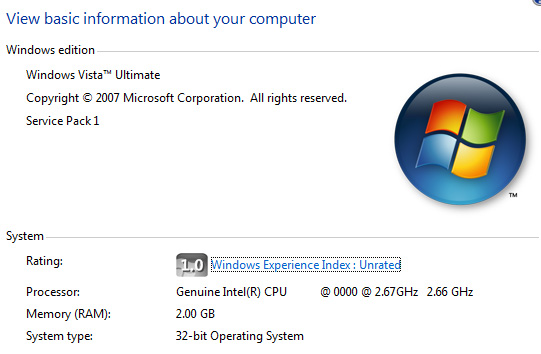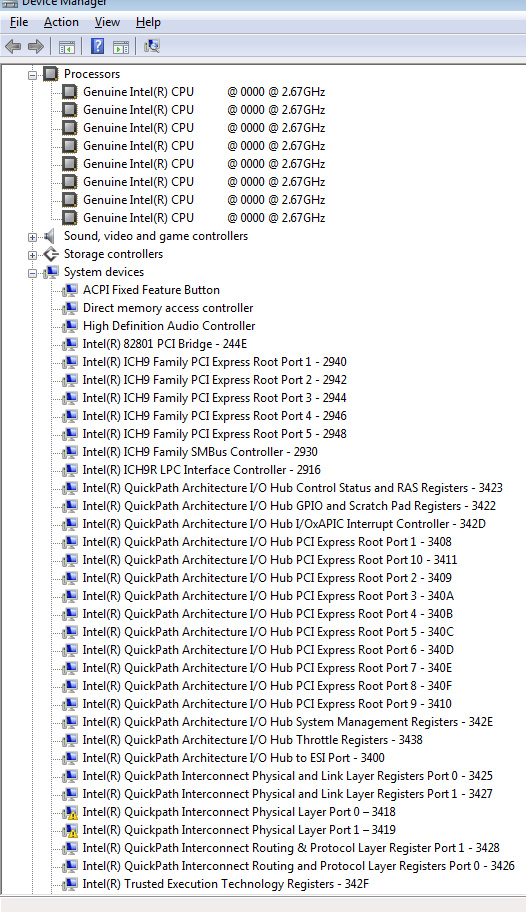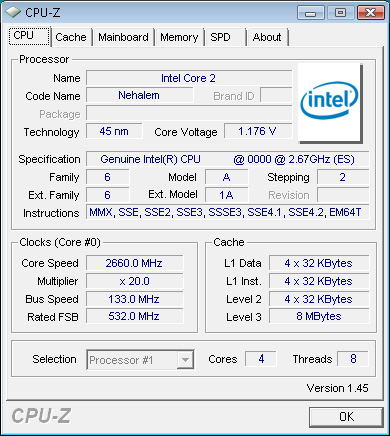The Nehalem Preview: Intel Does It Again
by Anand Lal Shimpi on June 5, 2008 12:05 AM EST- Posted in
- CPUs
Not One Nehalem, but Two
Nehalem itself is very stable but it has only been in Taiwanese motherboard manufacturer hands for a relatively short while now, so the only truly mature motherboards are made by Intel. Unfortunately since Intel didn't sanction our little Nehalem excursion, we were left with little more than access to some early X58 based motherboards in Taiwan. Thankfully we had two setups to play with, each for a very limited time.

We had access to a 2.66GHz Nehalem for the longest time, unfortunately the motherboard it was paired with had some serious issues with memory performance. Not only was there no difference between single and triple channel memory configurations, memory latency was high. We know this was a board specific issue since our second Nehalem platform didn't exhibit any issues. Unfortunately we didn't have access to the more mature platform for very long at all, meaning the majority of our tests had to be run on the first setup (never fear, Nehalem is fast enough that it didn't end up mattering).

The second issue we ran into was a PCI Express problem that kept us from running any meaningful GPU benchmarks. We've been told that it'll take the motherboard guys about a month to work out these kinks, but that's why you shouldn't expect to see a full performance evaluation of Nehalem in the near term.
The CPUs are quite mature and are running extremely cool (surprisingly cool actually), their clock speeds are being artificially limited by Intel in order to avoid putting all cards on the table at this time. We saw a similar approach with the very first Penryn samples which were all locked at 2.66GHz. The Intel X58 chipset we used in our testing on the other hand got quite hot.

Nehalem no longer has a conventional FSB, its clock speed is derived from a multiplier of an external clock frequency - in this case 133MHz. Expect all Nehalem chips to come out in frequencies that are multiples of 133MHz.
Thankfully we don't want a thorough look at Nehalem today, we'll save that for the launch - what we do want is to whet our appetite. We want to know if Intel can pull it off a second time.










108 Comments
View All Comments
kilkennycat - Thursday, June 5, 2008 - link
Isn't 6GB of RAM a pretty sweet spot for desktop 64-bit applications, whatever about servers?jimmysmitty - Thursday, June 5, 2008 - link
Well I have been waiting for Nehalem. I gave in and decided to build a rig with the Q6600 but kinda sad now.Anwways. Crank the Planet, hes not showing fanboyism. He stated Intel has been promising 20-30% increase with Nehalem. They are seeing 20-50% from these benchmarks. Take 21 and divide it by 14 that gives you 1.5. That means that the AMD Phenoms latency is about 50% slower.
If anything you are showing fanboyism. Nehalem is showing to be one hell of a chip and you are just angry that AMD has nothing to compare to it. Even after AMD finishes absorbing ATI whats next, K10.5 aka Deneb? Thats just a 45nm refresh (just like Penryn was for Conroe). Unless there are some major changes in the architecture it will just, hopefully, make Phenom run at higher clocks and cooler.
Other than that I can't wait to see what this does for games. I know that most games are more GPU dependant but I myself play mainly Valve games using Source and thats very CPU dependant and already runs great on my Q6600 but I want to see what this game will do for their particle and physics system...
Nehemoth - Thursday, June 5, 2008 - link
Please, Please, Please Intel I would to have this monsters chip in our servers without the annoying FBD, I don't want hoty FBD bring me normal DDR2 (without FBD) or DDR3.Just what I ask.
Griswold - Thursday, June 5, 2008 - link
I'm a big fan of multi-core systems, but I'm not blind to reality: Why no single threaded benchmarks, but only benchmarks that scale very good with more cores/SMT? By the time these things will be on the market, most applikations will still be single threaded and you know it...I just want to know how much faster it is per clock per core.
Anand Lal Shimpi - Thursday, June 5, 2008 - link
Interestingly enough, none of our standard CPU benchmarks are single threaded at all - even the most benign ones are multithreaded (including the games). I did run some single thread Cinebench numbers though:Nehalem - 3015
Q9450 - 2396
bradley - Thursday, June 5, 2008 - link
Why is there such a large discrepancy between previous single-threaded Cinebench tests from six months ago: where the Q9450 scored a 2944, or a mere 2.4% decrease, compared to the current 2396, or a more substantial 20.5% decrease.http://www.anandtech.com/printarticle.aspx?i=3153">http://www.anandtech.com/printarticle.aspx?i=3153
I too believe single-threaded benches should be the foundation of any meaningful and relevant cpu review, if time indeed was permitting. To me this is the greatest objective real-world equalizer. There just isn't enough multi-threaded software out there, much less software able to run all eight cores. I would also like to emphasize that unlike server chips, desktop Nehalems will only have two memory channels. And as I understand, hyper threading also will only make an appearance in server and enthusiast chipsets. So already this makes an accurate comparison difficult enough.
Finally, I understand the avg visitor will treat this like any good entertainment, where one is meant to suspend his-her disbelief. Still I have a hard time believing anyone has the ability to abscond away such important chips from a huge corporation like Intel. "Without Intel's approval, supervision, blessing or even desire - we went ahead and snagged us a Nehalem (actually, two) and spent some time with them." That initial premise does make anything coming after less impactful, or seemingly less than straightforward.
Certainly if history has taught us anything, we know final shipping silicon is sometimes quite different from test chips. We should also assume it's a lot easier to create ond one chip than manufacture hundreds of thousands on a large scale. Nothing is ever a given, which makes it hard to draw much of a conclusion. Interesting preview nonetheless.
SiliconDoc - Monday, July 28, 2008 - link
Shhhhh... gosh we have to have core hype ... and the multicore testers have to optimize for the coming chips... geeze they have to make a living somehow...( You sir, are exactly correct, but we live in a strange world nowadays where the truth is so evident it must be hidden most of the time for various other reasons... )
Gosh, you want to crash the whole economy with that sane and rational talk ?
What are you an anarchist ? ( yes I'm kidding, that was a big high five to you)
Anand Lal Shimpi - Thursday, June 5, 2008 - link
Ignore those numbers (check page 6 of the comments for an explanation), the Q9450 comes in at 2931 vs. Nehalem's 3015.-A
pnyffeler - Thursday, June 5, 2008 - link
I'm not a Mac person, but I think Mac's may benefit from this technology even more than Vista. As I recall from a previous Anandtech article, Mac's have an excellent memory management system, which very direct benefit in increasing memory size. The increased bandwidth could make the snazzy OS even better...Visual - Thursday, June 5, 2008 - link
It is great that your "clock for clock" comparisons to the penryn in encoding and rendering are showing an improvement... but could that improvement be from the doubled amount of virtual processors that are visible? Are all of these benchmarks using eight or four threads on the nehalem?